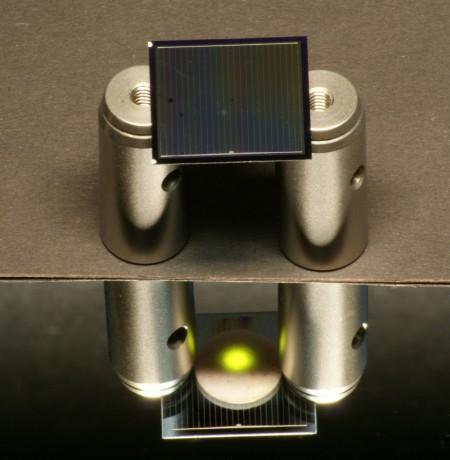 A two-sided silicon solar cell — positioned here on aluminum cylinders — is illuminated from
A two-sided silicon solar cell — positioned here on aluminum cylinders — is illuminated fromabove by an infrared laser. (Credit: Fraunhofer ISE)
Thermal radiation from the sun is largely lost on most silicon solar cells. Upconverters, however, can increase solar cell efficiency by transforming the infrared radiation into usable light. Researchers have now for the first time successfully adapted this effect for use in generating power.
There is more to solar radiation than meets the eye: sunburn develops from unseen UV radiation, while we sense infrared radiation as heat on our skin, though invisible to us. Solar cells also ‘see’ only a portion of solar radiation: approximately 20 percent of the energy contained in the solar spectrum is unavailable to cells made of silicon—they are unable to utilize a part of the infrared radiation, the short-wavelength IR radiation, for generating power.
Researchers of the Fraunhofer Institute for Solar Energy Systems ISE in Freiburg, together with their colleagues at the University of Bern, Switzerland, and the Heriot-Watt University in Edinburgh, Scotland, have now for the first time made a portion of this radiation usable with the assistance of a practical upconverter. The technology that transforms infrared into usable light has been known about since the 1960s. However, it has only been investigated in connection with solar cells since 1996. “We have been able to adapt both the solar cells and the up-converter so as to obtain the biggest improvement in efficiency so far,” reports Stefan Fischer happily, a scientist at ISE. The potential is big: silicon solar cells theoretically convert about thirty percent of sunlight falling upon them into electrical power. Upconverters could increase this portion to a level of forty percent.
However, how does the upconverter manage to utilize the infrared radiation for the solar cells? As solar radiation falls on the solar cells, they absorb the visible and near-infrared light. The infrared portion is not absorbed, however, it goes right through them. On the backside, the radiation runs into the upconverter—essentially a microcrystalline powder made of sodium yttrium fluoride embedded in a polymer. Part of the yttrium has been replaced by the scientists with the element erbium, which is active in the optical range and responsible in the end for the upconversion.
As the light falls on this upconverter, it excites the erbium ions. That means they are raised to a higher energy state. You can imagine this reaction like climbing up a ladder: an electron in the ion uses the energy of the light particle to climb up the first step of the ladder. A second light particle enables the electron to climb to the second step, and so on. An ion that has been excited in this manner can “jump down” from the highest step or state. In doing so, it emits light with an energy equal to all of the light particles that have helped the electron to climb on up. The upconverter collects, so to speak, the energy of several of these particles and transfers it to a single one. This has so much energy then that the solar cells “see” it and can utilize it. This article in Nanoscale Research Letters has more on upconversion in solar cells.
Researchers had to adapt the solar cells in order to be able to employ an upconverter such as this. Normally, metal is vapour-deposited on the backside, enabling current to flow out of the solar cells—so no light can shine through normally. “We equipped the solar cells with metal lattices on the front and rear sides so that IR light can pass through the solar cells. In addition, the light can be used by both faces of the cell—we call this a bi-facial solar cell,” explains Fischer. Scientists have applied specialized anti-reflection coatings to the front and rear sides of the solar cell. These cancel reflections at the surfaces and assure that the cells absorb as much light as possible. “This is the first time we have adapted the anti-reflection coating to the backside of the solar cell as well. That could increase the efficiency of the modules and raise their energy yields. The first companies are already trying to accomplish this by implementing bi-facial solar cells,” says Fischer, emphasizing the potential of the approach.

